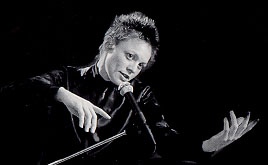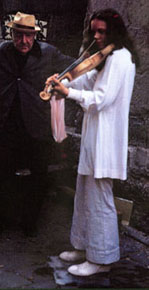
|
A while ago, I had this stiff neck. I couldn't get it out of this one position. I went to a doctor and he said, "Show me where it hurts." And I said, "Well, it sort of starts in my neck here, and runs down my arm, and kind of crumples up the fingers on this hand." And he said, "Exactly what is it that you do for a living?" From "Stiff Neck" "United States 4" 1983 |
If multi-media could be personified by a demigoddess of postmodern art with unruly, spiky hair and a penchant for violins, Laurie Anderson would be her. The spectrum of her talents include composing, writing, sculpting, printmaking, directing, art history, digital animation, and costume design, among the many others stashed safely away in her toolbox of performance art.

Born in a suburb of Chicago, Illinois, in 1947, her first great love was the violin, an instrument she still considers her alter ego. "It's the instrument closest to…the human female voice," Anderson states. "It's a romantic, nineteenth-century instrument, and…you can hold it, walk around with it" (Anderson, 33). Her variegated interests, however, impeded her from devoting all of her energy to one single thing, which may explain how so many elements blend together in the harmonious melting pot of her work. "I realized that to be a professional musician you have to practice all the time…and there were other things I wanted to do - speak German, learn about physics" (Anderson, 35).
While she might not have learned German or physics, her creative, inquisitive mind not only viewed the world from a different perspective, but also constructed ways to communicate these perceptions to others. From 1965-1972 she was immersed in the realm of academia, and she collected a bachelors degree in art history and an MFA in sculpture. While teaching art history in the universities of New York, she found a sort of comfort in the lecture itself, drawn to this semblance of performing in front of her students (Gaar, 76648lin.html). Her affinity for the slideshows and the lecture-like atmosphere of the university have since manifested as trademark elements in her performance pieces.
Anderson became heavily involved with the New York art scene. At the time, she hated the term "experimental" which was often applied to the work of this underground scene. However, she was, herself, the epitome of the walking experiment. She would spend a winter wearing no coat, fall asleep in public places to survey their effect on her dreams, or study the Buddhist concept of mudra, hand gestures used during meditation. On the street corners of New York City, wearing a pair of ice skates frozen tight in a block of ice, she would play a duet with the tape recorder she had attached to her violin. (Ironically enough, this fulfilled the public service requirement of a CAPS, or Creative Artist in Public Services, grant.)
Whether she was constructing interactive pieces of art, composing music (including the scores for Wings of Desire and Swimming to Cambodia) or bringing it all together in her multimedia performance pieces, she has been a woman who wears many faces, uses many voices, and brings a cohesiveness to fragmentation that is logically impossible. Most recently, Anderson has taken a ride with Herman Melville on the back of his famous whale, with Songs and Stories from Moby Dick, her latest performance tour. Find out more about this project and other recent Anderson achievements by visiting the official Laurie Anderson website.
